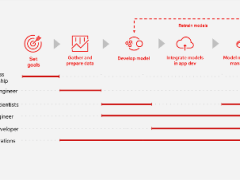During April, Check Point Software Technologies’ researchers uncovered a substantial Qbot malspam campaign distributed through malicious PDF files attached to emails seen in multiple languages. Meanwhile, Internet-of-Things (IoT) malware Mirai made the list for the first time in a year after exploiting a new vulnerability in TP-Link routers, and Healthcare moved up to become the second most exploited industry.
The Qbot campaign seen last month involves a new delivery method in which targets are sent an email with an attachment that contains protected PDF files. Once these are downloaded, the Qbot malware is installed on the device. Researchers found instances of the malspam being sent in multiple different languages, which means organisations can be targeted worldwide.
Last month also saw the return of Mirai, one of the most popular IoT malwares. Researchers discovered it was exploiting a new zero-day vulnerability CVE-2023-1380 to attack TP-Link routers and add them to its botnet, which has been used to facilitate some of the most disruptive distributed DDoS attacks on record. This latest campaign follows an extensive report published by Check Point Research (CPR) on the prevalence of IOT attacks.
There was also a change in impacted industries, with healthcare overtaking government as the second most exploited sector in April. Attacks on healthcare institutions have been well documented and some countries continue to face constant assaults. For example, cybercriminal group Medusa recently launched attacks on cancer facilities in Australia. The industry remains a lucrative target for hackers as it gives them potential access to confidential patient data and payment information. It could have implications for pharmaceutical companies as it could lead to leaks regarding clinical trials or new medical drugs and devices.
“Cybercriminals are constantly working on new methods to bypass restrictions and these campaigns are further proof of how malware adapts to survive. With Qbot on the offensive again, it acts as another reminder of the importance of having comprehensive cybersecurity in place, and due diligence when it comes to trusting the origins and intent of an email.” said Maya Horowitz, VP Research at Check Point Software.
CPR also revealed that “Web Servers Malicious URL Directory Traversal” was the most exploited vulnerability, impacting 48% of organisations globally, followed by “Apache Log4j Remote Code Execution” with 44% and “HTTP Headers Remote Code Execution” with a global impact of 43%.
Top malware families
Globally, AgentTesla was the most prevalent malware last month with an impact of more than 10% on worldwide organisations respectively, followed by Qbot and Formbook with a 4% global impact.
In South Africa, Emotet was the most prevalent malware last month with an impact of more than 8.56% on organisations, followed by Qbot with 7.81% and Formbook with a 5.54% impact.
- Emotet – Emotet is an advanced, self-propagating and modular Trojan that was once used as a banking Trojan, and currently distributes other malware or malicious campaigns. Emotet uses multiple methods for maintaining persistence and evasion techniques to avoid detection and can be spread via phishing spam emails containing malicious attachments or links.
- Qbot – Qbot AKA Qakbot is a banking Trojan that first appeared in 2008. It was designed to steal a user’s banking credentials and keystrokes. Often distributed via spam email, Qbot employs several anti-VM, anti-debugging, and anti-sandbox techniques to hinder analysis and evade detection.
- Formbook – Formbook is an Infostealer targeting the Windows OS and was first detected in 2016. It is marketed as Malware as a Service (MaaS) in underground hacking forums for its strong evasion techniques and relatively low price. FormBook harvests credentials from various web browsers, collects screenshots, monitors and logs keystrokes, and can download and execute files according to orders from its C&C.














